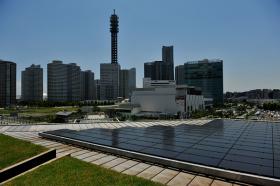

A sunny day always brightens me up- and this week in conference at the TED Global 2011 event in Edinburgh the Scottish weather has been kind enough that I have managed a sunny 20 minute walk to the venue twice in a row! This sunny start gives a kind of power- an optimism that helps kick start the day in the right way.
Solar power applied in a different way helps run a remarkable college in India where the incredible ingenuity of folk knowledge is collected and nurtured- The Barefoot College, indeed the only college in the world powered solely by solar power.
Presented at TED Global 2011 by the visionary Bunker Roy, this rural college boasts no highly academically qualified teachers; the learning transmitted here is distilled from people who quite simply know how to do things, and will invent ways of doing what they don’t already know how to do. Women from a rural environment with no formal education cook on solar cookers of their own devising- and the work of solar electrification is spreading out from the college by harnessing the power of diversity: grandmothers from 28 countries worldwide have been trained, then sent to villages as solar engineers http://www.ecotoolbox.com/ecoblog/2011/02/04/barefoot-grandmothers-electrify-rural-communities/ .
Innovation in the college calls on simple answers to basic obstacles. Where communication is hampered by illiteracy, puppets are employed to mediate and spread the word. Children working with livestock during the day learn in the evenings, and are empowered by the establishment of their own ‘government’ where the elected Prime Minister could be a young girl of 12.
In the face of this story of ‘barefoot creativity’, and the inspiring use of solar power, I thought of the possible role in off-grid areas in the world for the electric vehicles and batteries that are at the heart of the Alliance zero emission mobility activities. There are some heartening possibilities.
One of the first Nissan LEAF customers in the UK, radio DJ Mark Goodier, has solar roof panels installed that produce electricity to power his car. If this will work in cloudy London, how about India or Africa! This week at the Nissan Global HQ in Yokohama, Japan there was a demonstration of solar charging for car batteries from solar roof panels, and second use of electric car batteries for storage.
I heard, shortly after the catastrophic earthquake and tsunami in Japan this year, that the electric vehicle could have a role in areas where gasoline supplies are cut, and the battery storage capability can be used to provide power to cook food, sterilise hospital equipment and power countless other critical devices.
As the partnerships growing through the development of infrastructure for electric vehicles spread to more and more countries, so the folk knowledge will discover and harness the technology that accompanies this development. Perhaps on a village level there would be car sharing, providing not only motive power, but also storage for domestic use. Maybe communal refuse will generate hydrogen to run fuel cells.
Hearing the tales of the wise heads in the Barefoot College, I’m sure Alliance engineers will pull inspiration from diverse quarters in this exciting future for the automotive industry- they may even be learning at the feet of trained grandmothers! From such dreams and ‘what-if’s, global sustainability solutions will continue to be drawn.
